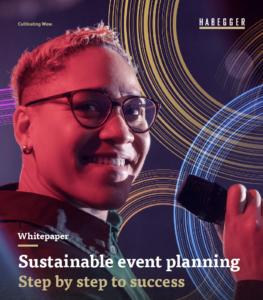We had a chat with Daniel Seitz, sustainability manager and co-owner of the Institut für Zukunftskultur. We spoke to him as part of our interview series "Sustainable brand presence – but how?" and wanted to know how live communication companies achieve a sustainable brand presence and what measures and factors are required for this.

Daniel Seitz, sustainability manager and co-owner of the Institut für Zukunftskultur
Daniel has 15 years of experience in climate projects. He has been working intensively on sustainability in relation to events and trade fairs for over three years now and emphasises the urgency of action in all areas.
At the Institut für Zukunftskultur, companies receive professional strategic advice for a sustainable brand presence. On the other hand, completely outsourcing the sustainability project, is inefficient, as essential expertise has to be integrated into internal processes.
Together with Habegger, the sustainability expert introduced the sustainability strategy in the company and provided support during the ISO-20121 certification.
The focus lays on action, not appearance. A stable foundation and continuous optimisations are necessary for a credible, sustainable brand presence. Authenticity is crucial to avoid greenwashing.
The time it takes to achieve a sustainable brand presence varies depending on the status quo and the objectives. It is a continuous process without an ending point. The earlier you start, the better, as the requirements are constantly increasing.
We analyse needs, define goals and use our core expertise in strategic sustainability management as well as our practical knowledge. A sustainable presence requires commitment from all departments. That’s why we start customer projects by involving many employees. Companies often fail to recognise the potential of their departments for greater sustainability. Even small measures make a difference.
But: simply getting started is useless. Measures are collected first, after their implementation is determined by the materiality analysis. Management support, human resources and a budget are required for implementation. The introduction of a management system enables a more sustainable brand presence.
On average, we work with our clients for 6-12 months to integrate the right formats and methods into management.
Within the company, there will be transformations that raise awareness, introduce structures and require higher budgets. Projects often come with high budgets, but the focus usually lays on the external effect only, while the background goes unnoticed, such as the tonnes of waste after a trade fair appearance. It is crucial not to be wasteful. The material cycle must be designed to be sustainable so that materials can be reused several times and building materials can be separated again.
For live communication projects, cooperation between the client and service provider is essential. A sustainable concept also requires the willingness of the client. However, it is a development process in which it is often necessary to weigh things up and find a solution. Less is often more at events. The aim is to create an overall concept that offers expandable stage and design elements, because more sustainable formats (will) strengthen the brand.
“Damage to your reputation is greater than the investment in a sustainable brand presence.”
Success is measurable, but not as a cross-company benchmark for an industry. Every company has to compare itself with itself, as the factors differ. Separate benchmarks should be set for each event or trade fair appearance so that they can be compared with each other. For example, the event participants’ arrival to the event can be measured as a percentage. Trash and fresh water are also measurable units for example.
Biodiversity is also important at outdoor events, for example by avoiding fireworks in favour of sensitive light and/or drone shows. The CO2 balance is measurable. Social sustainability and equality also play a role, e.g. gender ratio, gender communication and long-term partnerships that prevent additional costs as they can be planned in advance.
The saying, “the most sustainable event is the one that is cancelled,” doesn’t match my point of view. Experiences and emotions should continue to take place, only under more sustainable conditions. An event can grow far beyond itself and inspire people for the topic of sustainability. Visible innovations may be included and shown in the communication. Successes can be communicated step by step, even if they are not perfect.
The biggest CO2 emissions at an event get caused by traveling and catering. This area can be specifically addressed in communication and society can be sensitised to it. Companies can achieve a great deal by playing a pioneering role in communication. Openness and transparency do not create a culture of prohibition.
Each project is unique and offers the opportunity to make a contribution to a sustainable image. Companies can learn from others – copying is allowed – and adapt the approaches to their needs.
“Don’t be afraid of making mistakes, everyone makes them. Communicate openly, because standing still means falling behind.”
Read our white paper for six valuable tips on how to plan your event more sustainably and make your brand presence more sustainable.

Subscribe to our Newsletter and follow us on social media.
